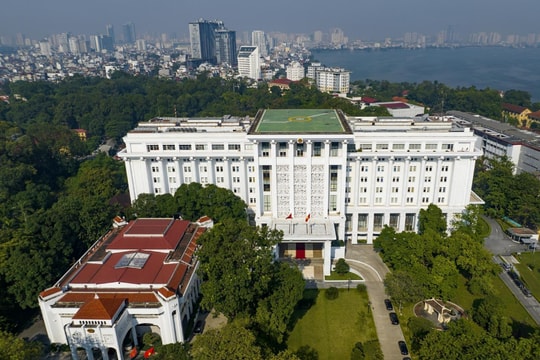New electricity prices force tens of millions of households to review their bills.
The Ministry of Industry and Trade is seeking public opinion on the 5-tier retail electricity price list, replacing the current 6-tier plan. Any retail electricity price list has both beneficiaries and losers. Therefore, tens of millions of households have to review their bills to adjust their consumption.
Why not choose the flat rate option?
In fact, electricity is a special commodity, different from many other common commodities. Mr. Nguyen Tien Thoa, Chairman of the Price Appraisal Council, when giving comments on the Project to Improve the Structure of Vietnam's Retail Electricity Price Table held on November 5, 2019, also said: The more you use, the higher the price you have to pay is essentially an economic logic that comes from the characteristics of the electricity system. That method is to solve the problem of electricity production costs, both in normal times and during peak load periods; it is necessary to mobilize electricity sources with different prices to meet consumer demand.
 |
According to Mr. Thoa, it is due to the Law of Resource Scarcity, because electricity is a resource converted from many non-renewable resources, and these resources are not endless, some are even gradually depleted (oil, coal, natural gas, ...) leading to electricity not being an endless resource but being wasted. On the other hand, the current electricity supply does not meet the annual electricity consumption rate.
Mr. Thoa said this to counter the opinions that our electricity prices are going against the principles of the market mechanism: "The more you buy, the cheaper the price, but the more electricity you buy, the more expensive it is."
"This is what makes it clear to the public why household electricity prices are not regulated at the same price as many opinions have suggested," Mr. Thoa explained.
The new price list has some winners and some losers.
Among the options proposed by the Ministry of Industry and Trade, there is a flat price option. This is a one-tier option, with the price equal to the current average electricity price for household use, which is 1,897 VND/kWh.
EVN data shows that there are more than 22 million customers using 300 kWh or less of electricity, accounting for about 72.6% of customers with 60% of electricity output.
The number of customers using from 400 kWh to under 700 kWh is about 1.2 million; from 701 kWh or more is more than 456 thousand customers. This number only accounts for 1.8% of the number of customers but the consumption output accounts for 13%.
Thus, if the electricity price is fixed at 1,897 VND/kWh, customers considered to have high incomes and electricity consumption of 300kWh or more will benefit from having to pay a much lower price than customers using less than 300kWh.
Specifically, 3.6 million households with electricity usage from 201 kWh/month to 300 kWh/month will have their electricity bill reduced by 8,000 VND/household/month. In addition, more than 3.1 million households with electricity usage from 301 kWh or more will have their electricity bill reduced by 80,000-330,000 VND/month.
Meanwhile, 18.6 million households use from 0-200 kWh/month, electricity bill increases from 17,000 to 36,000 VND/household/month. It is worth noting that the budget support for poor households and social policy households will also have to increase due to the increase in electricity price of level 1 (poor households are supported with 30 kWh/month).
Thus, the one-price plan makes low- and middle-income households pay more than they do now. Meanwhile, this plan does not encourage high-income households to use electricity more economically.
The 3-tier and 4-tier plans also have millions of customers paying higher prices. For example, the 3-tier plan has up to 22.3 million households using 0-300 kWh/month having to pay higher prices. The 4-tier plan also has about 15.3 million households using 0-50, 101-200 and 401 kWh/month or more having to pay higher electricity bills of 1,000 to 105,000 VND/household/month.
Therefore, the Ministry of Industry and Trade has chosen scenario 1 of option 5 when only 0.46 million households (accounting for 1.8% of the total number of households) using 701 kWh/month or more have to pay an additional 29,000 VND/household/month. The rest will not increase or decrease the electricity bill to be paid.
 |
| The difference between the new 5-step plan and the current 6-step plan |
Waiting for competitive retail electricity market
In reality, it is difficult to have a retail electricity price list that satisfies all households, each option has its own advantages and disadvantages. Reducing electricity prices for one group of customers means having to increase electricity prices for another group to compensate.
If we only build a new retail price list for household electricity, we cannot clearly see a significant change in the overall picture of electricity prices. Because household electricity is only one of four customer groups of EVN.
Specifically, EVN's retail electricity prices include four groups: One is the retail electricity price for manufacturing industries; Two is the retail electricity price for administrative and public service sectors; Three is the retail electricity price for business; Four is the retail electricity price for household use. The prices prescribed for these groups vary, but on average, they do not exceed the current retail price prescribed by the State at 1,864.44 VND/kWh. Of which, the retail electricity price for business is the most expensive, while the electricity price for production is the lowest.Notably, the electricity price for production is still believed to be "anchored" at a low level, to support production for businesses. The amount of electricity for production in 2018 accounted for about 60% of total electricity consumption. The average electricity price for production households is also very low, at 1,565 VND/kWh, the lowest among households.
Calculations by Mr. Bui Xuan Hoi (Department of Energy Economics, Hanoi University of Science and Technology) show that: The average selling price of business households in 2018 reached 2,644.8 VND/kWh at the same voltage level below 6 kV, 1.58 times higher than the average retail price for production households. Thus, the revenue of business households is helping to balance the total revenue of the electricity industry.
Household electricity accounts for 28% of total electricity consumption, with an average price of nearly 1,897 VND/kWh, slightly higher than the average retail electricity price (1,864.44 VND/kWh).
The ceiling price of electricity is 1,864.44 VND/kWh. Therefore, if there is no significant change in the policy on retail electricity prices for the above 4 customer groups, the issuance of the new retail price list for household electricity will still not have any breakthrough.
Suppose, not continuing to maintain low prices for the manufacturing customer group also creates conditions for other groups to be cheaper. However, this is a difficult choice because it can increase the production costs of the enterprise.
In general, for a significant change in electricity prices, users will have to wait at least until 2021-2023. That is when the competitive retail market will be born. At that time, EVN will no longer have a retail monopoly.
By then, retail electricity prices will be operated according to market mechanisms with the participation of many parties. It is impossible to predict whether the price will increase or decrease compared to the present.
But in an interview with VietNamNet reporters in May 2019, Mr. Franz Gerner, Head of the Energy Specialist Group, World Bank (WB) in Vietnam, noted: Experience from Latin America shows that most countries have stopped competitive retail markets when electricity demand continues to increase rapidly and new investments in power generation and grid cannot keep up.
That means, when there is a power shortage and demand is greater than supply, it is very difficult for a competitive retail electricity market to operate smoothly.

.jpg)
.jpg)

.jpg)



